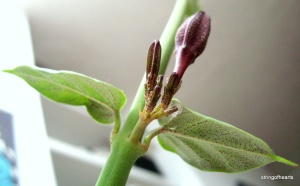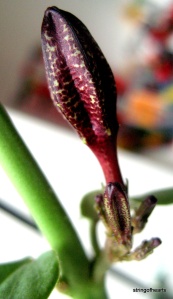This is one of those thick-stemmed Ceropegia which if left to its own devices ends up as a long bare stem with a couple of leaves and flowers at the top. You are unlikely to discover this until you see the plant in the flesh because photographs, unsurprisingly, tend to focus on the interesting features, namely the leaves and flowers. In the interests of honesty, I have tried to photograph the whole plant although not entirely successfully. To be fair, I have not worked that hard on making it presentable and it does have its own kind of ‘style’ in the flesh which is hard to capture photographically.
The problem with this as a houseplant, is that the few leaves which are formed seem to die off naturally. At the same time, common wisdom seems to suggest that some of the naturally ‘leggy’ Ceropegia should not be cut back because this will inhibit flowering. However, there are other sources on the internet which suggest that this is one Ceropegia which should be cut back. And there are certainly some lovely pictures with lots of lush new growth which suggest that this is the case. Now that I have got the plant to flower for myself and seen what it has to offer, I haven’t got much to lose and will experiment with cutting it back when the flowers are over. The other option is to twin two Ceropegia together, allowing a vigorous but more delicate climber to grow up the thicker stem, which happened by accident with my Ceropegia succulenta and carnosa.
Ceropegia rupicola comes from Yemen and is known locally as Bukira – if anyone knows why or what this means, please let me know. Apart from its length and the associated problems of support, it is an easy plant to grow. I watered it very sparingly in the Winter, stepped up the watering early in the year and the buds began to form a few weeks ago. I have not yet fed any of my Ceropegia, unless by accident, because there seem to be so many dos and don’ts that it seems easier to err on the side of caution. The flowers apparently vary from plant to plant. Most are some shade of red, either pure or with other colouration. Those on this plant are very dark red and speckled a kind of yellow-green. (The speckling on the undersides of the leaves is red on yellow-green offering an interesting reverse image.) This speckling seems to decrease with age, being most prominent in the younger buds and almost absent from the older flower. All the flowers have slits which are so small as to be barely visible – in complete contrast to the more showy Ceropegia sandersonii.




